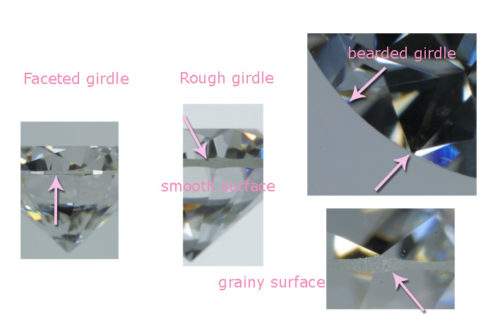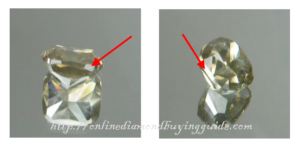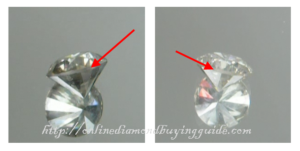
There are three types of girdle finish: bruted, polished and faceted. In actual fact, the type of girdle finish has little effect on the brilliance of a stone.

Just a few decades ago almost all round brilliant cuts had a bruted girdle because of the way diamonds were cut. It is a single, continuous, unpolished surface going around the circumference of the diamond. This frosty appearance is created when a rough stone is rounded against another rough stone in a process called bruting. Today, with the availability of modern machining equipment, most girdles are either polished or faceted
Types of Finish Performed on the Girdle
If a bruted girdle is badly done it is known as a “bearded girdle” because the girdle’s surface resembles a man’s beard. Viewed under magnification, it can be seen to have many tiny “feathers” which gives the diamond an opaque and frosty appearance. In badly worked diamonds the feathers can even extend into the diamond’s body and become marked as inclusions.
There is little benefit to having a bruted girdle. In the case of a bearded girdle, the risk of having numerous “miniature cracks” around the diamond, provides little protection should the stone get damaged or knocked.
The most common types of finish found in modern day diamonds are polished and faceted girdles.
In polished girdles the entire girdle is polished into a single large and clear facet around the circumference of the diamond, thus enabling one to see through into its body. This is more uncommon in round stones, but is more common for square or rectangular diamonds, given their shape.

In the faceted finish a series of very small facets are made around the entire circumference of the diamond. This process removes any tiny feathers which may have been caused in the bruting process. A faceted girdle gives a cleaner and more complete look to the diamond. The additional facets allow the light to reflect off the girdle, providing extra brilliance, especially when viewed from the side.

Leading Diamond laboratories, such as the GIA, only evaluate the thickness of the girdle and not the appearance. Therefore, if it is too thick or too thin, it can effect the overall grading of the stone.

